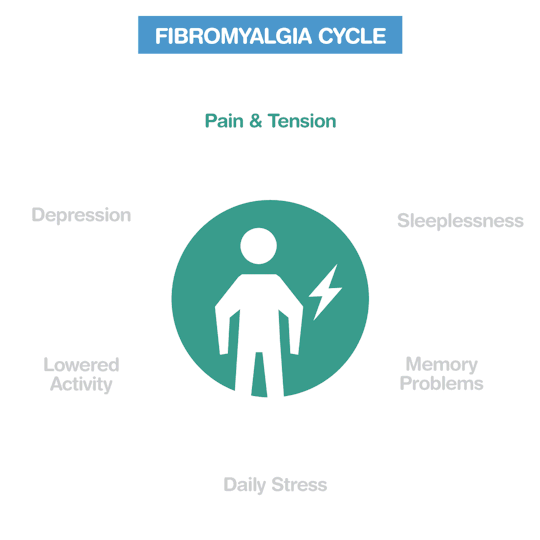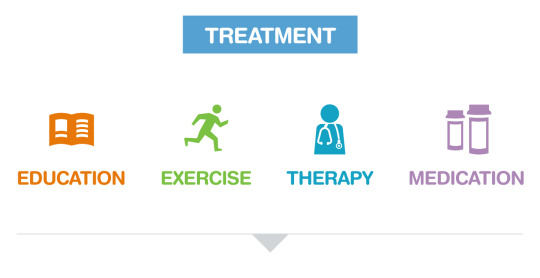
Fibromyalgia is an ongoing pain condition that impacts more than just your body—it can also cycle into fatigue, sleeplessness and emotional distress.
There’s no foolproof way to treat fibromyalgia pain. However, you can ease its symptoms when you understand the condition’s cycle.

What do we know about fibromyalgia?
Symptoms of
fibromyalgia can include:
- Pain, aching, soreness, stiffness,
burning or throbbing all over the body. The pain is always present, but certain
events may intensify it. These can include poor sleep, stress, exertion or cold
or damp weather. - Tiredness.
- Disrupted sleep and sleep disorders,
such as sleep apnea and restless legs syndrome. - Tingling, numbness or “crawling”
sensations in the arms and legs. - Headaches, including migraines.
- Depression and anxiety.
- Cognitive problems, such as trouble
focusing, paying attention or concentrating.
Fibromyalgia
doesn’t cause tissue inflammation or harm the joints, muscles or other tissues
like arthritis does. However, many people with fibromyalgia also have other conditions
that can cause pain , such as rheumatoid arthritis, irritable bowel syndrome,
bladder problems and temporomandibular joint disorders.
There’s no
one test used to diagnose fibromyalgia. In fact, it’s often difficult to
diagnose since the primary symptoms of fibromyalgia – pain and tiredness – also
are symptoms of many other conditions. Your health care provider will look at
your health history and do an exam. They’ll likely also do blood tests to rule
out other causes of your symptoms.
Treatment has four components

Education
Learning
more about fibromyalgia and how to care for yourself is often the first step in
managing your health. You’ll learn that your symptoms may be worse at times and
better at others. Adopting habits to improve the quality of sleep, keeping stress levels in check and
staying on top of your treatment plan may improve your quality of life.
Exercise
When you’re
in pain and feel tired, exercise may be the last thing you want to do. You may
even worry that it will make your symptoms worse. But while fibromyalgia is
painful, the condition doesn’t appear to cause tissue, joint or muscle damage. In
fact, studies show that regular aerobic exercise can be helpful for people with
fibromyalgia. Low-impact activities like swimming, biking or brisk walking may
ease muscle pain and improve muscle strength. Mind-body practices, such as yoga
and tai chi, may also help. Gradually
work your way up to at least three 30-minute fitness sessions each week. Always
check with your health care provider before increasing your activity level. They
may suggest that you work with a physical therapist to create a fitness plan
tailored to your needs.
Therapy
Counseling
and relaxation therapies may help relieve stress and aid in managing symptoms.
Often used to treat depression, cognitive behavioral therapy can help change
the way you cope with pain. This approach seems to be helpful when combined
with education. Hypnosis and biofeedback (a technique where you learn to
control certain body functions, such as your heart rate) may also provide some
relief.
Medication
Many people
with fibromyalgia need medication along with other treatments. Commonly used medicines
for fibromyalgia include:
- Anticonvulsants. Primarily used to treat seizures, the
anticonvulsants gabapentin and pregabalin may ease pain and improve sleep. - Antidepressants. Duloxetine and milnacipran may reduce fibromyalgia symptoms
even in people who aren’t depressed. They have been shown to lessen pain and
fatigue and enhance quality of life. Amitriptyline and the muscle relaxer cyclobenzaprine
can also be used to improve sleep.
Your health care
provider may suggest other medicines to help your symptoms. Over-the-counter (OTC)
pain relievers can reduce the aches and pains for some people. However, certain
pain medicines may be more helpful for fibromyalgia than others. Check with
your doctor or pharmacist before trying any new OTC medication.
Managing the
chronic pain and fatigue caused by fibromyalgia can be challenging. It may take
trial and error to find the strategy that works best for you. Know that research
is learning more about what causes the syndrome and what treatments symptoms respond
to. Be open with your health care team about how you feel and keep up with
checkups. Working closely with those involved in your care is the best way to find
a treatment plan that works for you.
By: Jen Matz, MPH
Medical Writer, Clinical Programs & Quality, Walgreen Co.

Sources:
https://www.uptodate.com/contents/fibromyalgia-beyond-the-basics
https://www.uptodate.com/contents/initial-treatment-of-fibromyalgia-in-adults
https://www.niams.nih.gov/health-topics/fibromyalgia/advanced
https://www.cdc.gov/arthritis/basics/fibromyalgia.htm
https://www.mayoclinic.org/diseases-conditions/fibromyalgia/diagnosis-treatment/drc-20354785


